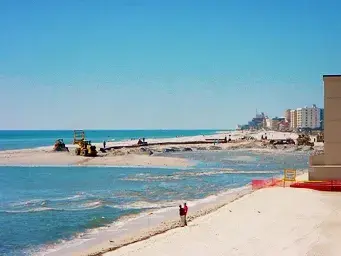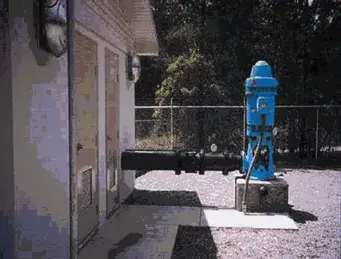Projects having the potential to impact Alabama's coastal resources are subject to review pursuant to ADEM's Coastal Rules. Fee Schedules can be located under Regulations / Division 1 Section 6. Some of these projects include:
- Construction on Gulf-fronting properties
- Commercial and Residential Development on Properties Greater than 5 Acres
- Projects Impacting Wetlands and/or Water Bottoms
- Construction of new, or expansion of existing marinas
- Installation of Groundwater Wells with a Capacity Greater than 50 gallons per minute (GPM)
- Siting, Construction and Operation of Energy Facilities
- Shoreline Stabilization Projects
- Discharges to Coastal Waters
Construction on Gulf-fronting Properties
ADEM Division 8 Coastal Programs rules require that an ADEM permit or other authorization be obtained prior to constructing any new structure or substantially improving any existing structure, on a property intersected by or seaward of the ADEM construction control line.
This includes habitable structures( single family dwellings, duplexes, motels, hotels and condominiums), non-habitable structures (gazebos, dune walkovers, etc.) and hardened erosion control structures.
A permit application can be obtained from ADEM's Mobile Coastal Office or an application may be downloaded by selecting the link below:
- Application for Single Family Dwellings, Duplexes and Similar Structures
- Application for Multi-unit Residential and Commercial Developments
The Cities of Gulf Shores and Orange Beach, the Town of Dauphin Island, and the Baldwin county Commission are delegated to implement the permitting, monitoring and enforcement section of the ADEM Division 8 Coastal Program rule related to construction on Gulf-fronting beaches and dunes. Persons wishing to conduct such activities should contact the local building department with jurisdiction for the area of proposed contruction.
 | Balancing impacts from development and environmental concerns is a major effort of the Alabama Coastal Area Management Program. |
Commercial and Residential Developments Greater than 5 Acres in Size
ADEM Division 8 Coastal Program rules require that a permit be obtained for all new commercial and residential developments located wholly or partially within the coastal area which are or will be greater than five (5) acres in size and which:
- have areas which are or could be delineated as wetlands; or
- are adjacent to coastal waters; or
- are intercepted by the coastal control line.
Permit applications can be obtained from the Coastal Section Office by calling (251) 432-6533 or you can download the form Permit Application for Developments and Subdivisions of Property Greater than 5 Acres in Size.
Projects Impacting Waterbottoms or Wetlands
Projects which include potential impacts to waterbottoms or the dredging and/or filling of wetlands will require permits and/or certifications from ADEM, the U.S. Army Corps of Engineers(USACE), and, in some instances, the State Oil and Gas Board.
The ADEM review of these types of projects is normally initiated when the property owner makes application to the U.S. Army Corps of Engineers.
Some of these projects, such as the construction of residential piers and projects involving minimal wetlands impacts, may be permitted under a pre-certified USACE General or Nationwide Permit and will not require further review by the Department.
Many projects will require an Individual Permit from the USACE, which will be jointly reviewed by the USACE and ADEM concurrently. This includes:
- Marinas, including the expansion of existing marinas
- Shoreline stabilization such as seawalls, bulkheads, jetties, groins and similar structures
- Beach nourishment projects
- Major dredging projects
- Projects involving more than minimal impacts to wetlands
- Placement of oil and gas platforms over waterbottoms
 | ADEM cooperated with the City of Gulf Shores, ALDCNR-State Lands Division and the Corps of Engineers to approve the Gulf Shores Beach Nourishment project, which was completed in Spring 2001. |
Groundwater Wells with a Capacity Greater than 50 GPM
The installation of a new well, or alteration of an existing well, for the purposes of extracting groundwater at a rate of 50 gallons per minute or greater requires a permit from the Department.
This provision is applicable to a well whose surface location is in the coastal area and one whose surface location is not in the coastal area but whose 50 year capture zone extends into the coastal area.
Permit application can be obtained from ADEM's Coastal Section or download the form Permit Application for Groundwater Wells with a Capacity Greater than 50 PGM.
 | Groundwater wells are a vital source of drinking water in the Coastal Area. |
Siting, Construction and Operation of Energy Facilities
All new energy facilities located wholly or partially within the coastal area, including those located in federal waters off of Alabama, and which require a federal license or permit or a state agency permit, must also receive coastal consistency from the Department.
ADEM rules prohibit the discharge of produced waters, drill muds and/or cuttings, and/or other discharges resulting from energy exploration or production activities, to the coastal waters of Alabama.
In an average year, ADEM reviews 40 coastal consistency requests for natural gas and oil exploration and productions activities in the federal waters off Alabama's Gulf coast.
 | A natural gas production platform and drilling rig at the mouth of Mobile Bay off Dauphin Island |
Discharges to Coastal Waters
ADEM Coastal Program rules require that certain types of NPDES wastewater discharges to the coastal waters of Alabama perform specific types of environmental monitoring. This monitoring is to occur within the immediate vicinity of the discharge, commonly referred to as "discharge information zone", and includes sampling of water, sediment and benthic macro-invertebrates. The specific requirements can be found in Administrative Code R 335-8-2-.12 and recommendations for preparing and implementing a DIZ monitoring program are included in the Water Division Permitting Guidance section.

